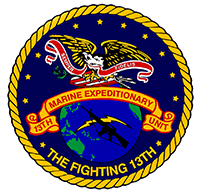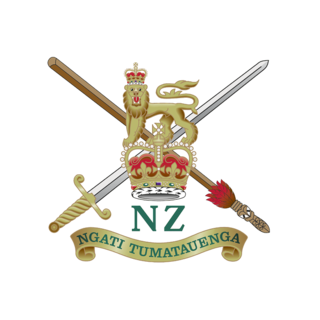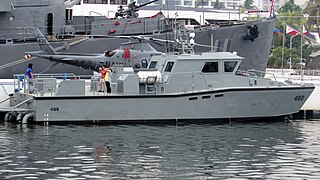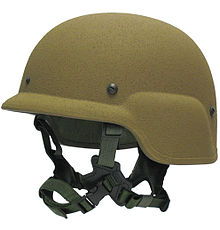
An amphibious transport dock, also called a landing platform dock (LPD), is an amphibious warfare ship, a warship that embarks, transports, and lands elements of a landing force for expeditionary warfare missions. Several navies currently operate this kind of ship. The ships are generally designed to transport troops into a war zone by sea, primarily using landing craft, although invariably they also have the capability to operate transport helicopters.
The Interceptor Multi-Threat Body Armor System (IBA) is a bullet-resistant body armor system that was used by the United States Armed Forces during the 2000s, with some limited usage into the mid-2010s. IBA and its design replaced the older standardized fragmentation protective Personnel Armor System for Ground Troops (PASGT) body armor system that was designed in the late 1970s and introduced in the early 1980s.

Personnel Armor System for Ground Troops is a combat helmet and ballistic vest that was used by the United States military from the early 1980s until the mid-2000s, when the helmet and vest were succeeded by the Lightweight Helmet (LWH), Modular Integrated Communications Helmet (MICH), and Interceptor Body Armor (IBA) respectively.

The Modular Integrated Communications Helmet (MICH) is a U.S. combat helmet and one of several used by the U.S. military. It was developed by the United States Army Soldier Systems Center to be the next generation of protective combat helmets for use by the U.S. Army.
The National Film Award for Best Direction is an honour presented annually at India's National Film Awards ceremony by the Directorate of Film Festivals (DFF), an organisation set up by the Indian Ministry of Information and Broadcasting. Since 1967, the award is given by a national panel appointed annually by the DFF to a director for their work within Indian cinema. It is presented by the president of India at a ceremony held in New Delhi.

The Advanced Combat Helmet (ACH) is the United States Army's current combat helmet, used since the early 2000s. It was developed by the United States Army Soldier Systems Center, the U.S. Army Special Operations Command, and the U.S. Army Research Laboratory to be the next generation of protective combat helmets for use by the American ground forces. The ACH is derived from the Modular Integrated Communications Helmet.

The 13th Marine Expeditionary Unit is one of seven Marine Expeditionary Units currently in existence in the United States Marine Corps. The Marine Expeditionary Unit is a Marine Air Ground Task Force with a strength of about 2,200 personnel. The MEU consists of a command element, a reinforced infantry battalion, a composite aviation squadron and a combat logistics battalion. The 13th MEU is currently based out of Marine Corps Base Camp Pendleton, California.

The AN/PVS-14 Monocular Night Vision Device (MNVD) is in widespread use by the United States Armed Forces as well as NATO allies around the world. It uses a third generation image intensifier tube, and is primarily manufactured by Litton Industries and Elbit Systems of America. It is often used 'hands free' using a head harness or attached to a combat helmet such as the PASGT, MICH TC-2000 Combat Helmet, Advanced Combat Helmet, Marine Lightweight Helmet or IHPS. It can also be used as a weapons night sight. In addition, it was part of the equipment fielded in the U.S. Army's Land Warrior program. Morovision Night Vision was the law enforcement distributor of the NEPVS-14 for ITT.

The CG634 is the Canadian Armed Forces' main combat helmet. It was introduced in 1997 and is based on the French Gallet TC-3 helmet. The helmet has protection equal to an NIJ Level 3a rating, being able to stop a shot from a .357 Magnum.
The Enhanced Combat Helmet (ECH) was the standard issue combat helmet of the Australian Defence Force, introduced in 2004 to replace the M91 helmet, an Australian version of the American PASGT helmet, it was replaced by the Team Wendy EXFIL Ballistic helmet from 2015

The Enhanced Combat Helmet (ECH) is a combat helmet designed in conjunction of a joint program of the United States Marine Corps and United States Army to replace the current combat helmets in use by the U.S. Army, Marines, Navy, and Air Force. Although similar in shape of the Advanced Combat Helmet and its predecessor the Modular Integrated Communications Helmet, the ECH is instead constructed using thermoplastics instead of the ballistic fibers used on previous-generation combat helmets.

The New Zealand Army uniform has changed over the years from that of the original Armed Constabulary of the 1800s to the modern Army Combat Uniform style in use by the majority of world armies today. While British Army influence has always been strong, distinctive New Zealand features have gradually developed. From 2013 the New Zealand Army uniform underwent a complete redesign with a new and distinctive camouflage pattern unique to the NZDF.

The Multi-Purpose Assault Craft (MPAC) is a type of fast attack assault craft developed by Taiwan for the Philippine Navy. Originally designed to transport troops at a high speed and then land them on the beach, they have since expanded their roles to include interdiction, surface warfare, and search and rescue.

Carl Epting Mundy III is a retired lieutenant general in the United States Marine Corps, who last served as commander of the United States Marine Forces Central Command. He previously served as commander of the United States Marine Forces Special Operations Command. He is the son of Carl Epting Mundy Jr., who was a Marine Corps general and Commandant of the Marine Corps.

Central Volunteer Headquarters, Royal Corps of Signals is a special administrative group of the Royal Corps of Signals formed to oversee the national reserve units of the corps.


















